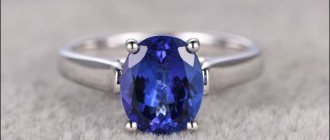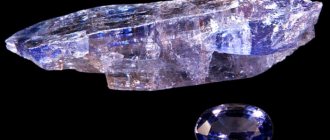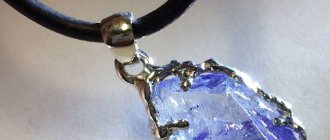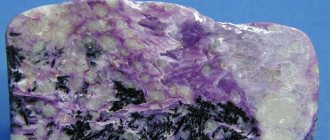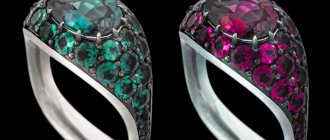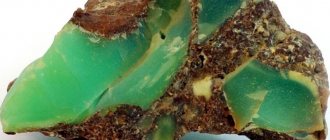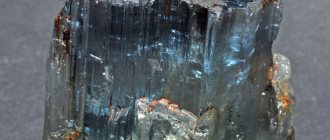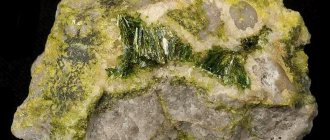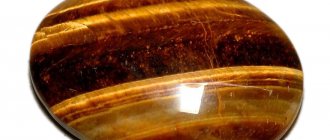The color of tanzanite ranges from sapphire blue to deep purple. Existing yellowish-brownish specimens are not popular in the jewelry industry.
Advertising - Continued below
In addition, the stone has an alexandrite effect and changes color depending on the lighting and even viewing angle.
History and origin
The mineral tanzanite or blue zoisite has two stories about the appearance of nuggets on the market. They agree on only one thing - they discovered the stone in 1967 near Kilimanjaro. The origin of the gem is due to rock pressure and high temperatures during the collision of two continents at this point 580 million years ago. And the name is the country of discovery, Tanzania.
Tanzanite
A more common version of the story claims that the first specimens of the stone were found by a prospector from Portugal, Manuel de Souzo. A man was brought to the East African state in search of rubies. He wandered around the country with an expedition of representatives of the local Maasai tribe until he came across a nondescript brown-purple stone on the Merelani plateau. Manuel mistook the find for a sapphire, but after checking it turned out to be a variety of zoisite, which is far from jewelry.
Another version of the story attributes the discovery of the tanzanite mineral to the aforementioned tribal shepherd Ali Juyawati. He discovered the nugget after a fire on the plateau, when the fire destroyed the top layer of soil. Ali took the find to the same de Souzo, but the ruby merchant considered it useless.
Over the next year, the mystical tanzanite stone remained on the fringes of the industry, and then luck smiled on it. The gem was appreciated by the vice president of Tiffany. The jewelry house threw all its efforts into gaining a monopoly on the market, but the plan failed.
Tanzanite
It turned out that the company independently deprived itself of success. Its specialists spent millions on field development and advertising campaigns. They even gave the name to the mineral at Tiffany. The previous name - zoisite - was very similar to the word “suicide” and unsuccessfully characterized the new “brand”.
This activity attracted the attention of the whole world, and the price per carat of tanzanite increased significantly. Realizing de Souzo's mistake, local gangs and others wanting to make money divided the deposit into many areas. They were difficult to manage, supply disruptions became increasingly frequent, and Tiffany had to give up its market share.
The tanzanite gem gained even greater popularity with the release of the film “Titanic,” where it “performed the role” of the blue diamond “Heart of the Ocean.” The stone behind it is sapphires, and became part of the famous necklace.
In the 50 years since the world became familiar with the mineral, its value has also been affected by the fact that no other deposits of the rock have yet been found. Geologists generally doubt the possibility of such unique conditions existing on the planet that allowed tanzanite to appear. According to the wildest assumptions, the reserves of the gem will last for 20 years, and its price will increase further in the near future.
Tanzanite deposits
The high cost of the unique stone was initially determined by the fact that there is only one deposit in the world where it is mined. It is located in Tanzania, near Mount Kilimanjaro. And in the next decade, according to experts, it may be exhausted.
If other expensive precious stones - sapphire, emerald and others - were known even before our era, then tanzanite is a “contemporary”, as it was discovered in 1967, and received its name thanks to the jewelry ]Tiffany & Co.[/anchor] - It was she who suggested naming the stone after the place where it was mined.
Advertising - Continued below
Physicochemical characteristics
It is not for nothing that the stone collides with sapphire several times in its history - they are quite similar in appearance. But the physical and chemical properties of tanzanite stone are completely different.
| Formula | Ca2Al3(SiO4)(Si2O7)O(OH) |
| Color | Sapphire blue to amethyst purple |
| Shine | Glass |
| Transparency | Transparent |
| Hardness | 6,5 — 7 |
| Cleavage | Perfect |
| Kink | Uneven. fragile |
| Density | 3.35 g/cm³ |
Place of extraction
Natural blue zoisite is mined from a small area of the Merelani plateau. Development is carried out underground, on a narrow strip about 5 kilometers long. The tanzanite crystal has grown on the rock, “hiding” in cracks and crevices.
Development at Merelani is being carried out by companies from the UK, South Africa and Tanzania itself. The latter controls a two-kilometer section, and with it up to 60% of the sales market. In total, the plateau is divided into 4 areas. Tanzanite deposits are designated by letters - A, B, C and D, and differ in management companies and conditions. Site C is considered the most convenient for mining, while site D is considered less attractive, rocky and inaccessible.
Varieties and colors
Most often, tanzanite is found in the form of unremarkable brown-brown nuggets. They are not used in jewelry in their original form, but are first subjected to an annealing procedure. Heating the stone to 400–650 °C allows you to remove unwanted inclusions, emphasize the deep sapphire color, or completely discolor the crystal.
All found specimens of the gem are divided into 2 large groups: with a predominance of purple or blue. One of the varieties of the stone is the concentration of vanadium and chromium ions. The content of compounds is responsible for the final leading shade.
But this does not mean that the color of the stone is limited to only the above two.
In nature, large minerals of green, violet, sapphire colors are found, less often - small pink, lavender and transparent. Often most of the shades are combined in one nugget. Tanzanite is characterized by pleochroism - its color changes depending on the viewing angle and lighting.
Colors and physical properties
The color of this stone is very varied. There are brown, yellow-green, violet, sapphire and greenish-blue shades. Light pink and even colorless samples are also possible.
One of the features of tanzanite is considered to be pleochroism - the property of changing its shade when the angle changes while viewing. Basically, one crystal can produce several shades, such as purple, blue and blue or red, violet and dark blue.
Some samples may produce an “Alexandrite” effect (color change when illuminated). For example, in artificial light, the stone has a purple tint, and in daylight it has a blue tint. The most unique is the blue-lavender tanzanite, and the most valuable stone is the deep blue one. You can also find a crystal that has a cat's eye effect.
Using heat treatment, experts get rid of brown and yellow shades and give the mineral a blue color.
Recently, green tanzanite was discovered, which combines light yellow and grey-green tints.
This stone is considered very fragile. Very often, setters in jewelry production refuse to work with tanzanite, since one awkward movement can split the expensive mineral.
The stone is transparent. It has perfect cleavage in only one direction, coinciding with the color of pleochroism. For lapidaries this is a whole problem. The crystals have a prismatic shape and are quite soft. The stone has a glassy sheen and a white streak.
Medicinal properties
The main healing property attributed to the stone is its ability to gradually restore lost visual acuity. The effect helps those who see worse due to constant work at the computer or with small details. If you regularly admire the jewelry and peer into the transparent tanzanite stones, the tension in your eyes will go away.
Purple tanzanite
The relaxing property helps owners of the mineral fight constant headaches and migraines. To do this, you need to often wear earrings with a gem for preventive purposes, or at least put them on during attacks. But bracelets with semi-precious tanzanite stone will save you from back pain.
The therapeutic effects of the nugget promise to get the owner back on his feet faster after a cold and relieve fever.
The mineral is believed to strengthen the immune system and help the body fight viruses. Anyone who carries it with them constantly gets sick less often and experiences acute respiratory viral infections and acute respiratory infections much easier.
Tanzanite jewelry in the form of a pendant or necklace can speed up the treatment of cosmetic blemishes on the face, such as acne or blackheads. For the same purpose, it is recommended to wash your face with water in which a bright crystal has been kept for some time. A ring with tanzanite in gold will relieve skin problems on the body. It will also help you relax after a hard day and improve your sleep.
Talismans, amulets, stone astrology
Tanzanite, considered a symbol of luxury and love, has been used as magical objects by the Maasai tribes since ancient times. He acts as a talisman for those people who strive for family happiness and enrichment. Any product can act as a talisman, such as earrings or a pendant, or simply a stone not attached to anything. A brooch or pendant brings success in your career, and a ring with a similar decoration ensures family happiness.
It is believed that a woman should wear tanzanite earrings to enhance her beauty and attractiveness. The mineral gives a woman brightness, self-confidence and indispensable charm. You need to know that in love this stone provides assistance exclusively to married couples, and may lose its properties if a person strives for love without wanting to start a family.
In astrology, tanzanite is ruled by the planet Saturn. Astrologers cannot say for sure which sign it is considered a stone of. But many experts consider it more suitable for the zodiac signs of the water element, for example, such as Pisces, Aquarius, Cancer, as well as the representative of the Earth element - Capricorn. In addition, this talisman will be indispensable for Aries; it adds chastity and composure, balance and tranquility to them.
Tanzanite will not cause harm, but will not give much strength to the other signs of the Zodiac - Taurus, Gemini, Leo, Sagittarius, Virgo, Scorpio and Libra.
Magic properties
The magical properties of tanzanite stone make it useful in resolving family and work conflicts, in self-determination and finding a life partner.
Varieties of Tanzanite
By purchasing it, people hope to use the powers of the gem in 5 directions:
- The mineral is suitable for beginners and experienced psychics. The stone reveals the gift of clairvoyance and enhances the abilities of seers. For people who are far from extrasensory perception, these properties of mystical tanzanite will teach them to listen to their intuition and choose the right path.
- Magical characteristics create an aura of calm and balance around the owner of the nugget. Quarrels arise less often around a person - all misunderstandings are resolved through peaceful negotiations. The mineral brings comfort to the home, the work team gets rid of gossip and intrigue, and makes the group of friends more united.
- The very fragile stone tanzanite, as if compensating for its natural characteristics, strengthens the family. He forces spouses to remain faithful to each other, sending minor troubles to the traitor. Problems will haunt a person until he returns home. The stone also attracts love to lonely people, you just have to sincerely wish to meet your soulmate.
- Jewelry made from the mineral attracts additional monetary resources to a person. Only wealth will not fall from the sky; the gem does not like lazy people. Only those who make commensurate efforts will receive a generous reward.
- A nugget is suitable for a person who has not yet decided on his occupation. It focuses the owner’s attention on the most striking abilities and helps to choose what will bring profit, allow self-realization and pleasure.
Who is suitable according to their zodiac sign?
Astrologers have different opinions on which zodiac sign suits tanzanite most. Some consider it an excellent “soothing” for representatives of the fire element, while others consider it the most suitable stone for Air signs. In any case, the gem will not cause harm to representatives of other signs, but will only strengthen or weaken their characteristic features.
| Zodiac sign | Compatibility |
| Aries | +++ |
| Taurus | + |
| Twins | + |
| Cancer | + |
| a lion | + |
| Virgo | + |
| Scales | + |
| Scorpion | + |
| Sagittarius | + |
| Capricorn | + |
| Aquarius | + |
| Fish | + |
(“+++” – fits perfectly, “+” – can be worn, “-” – is strictly contraindicated)
Compatibility with other stones
This beautiful, bright gem is self-sufficient and does not need support. Other stones often spoil it and distract attention from the main thing. Only diamonds can always successfully emphasize the appearance and enhance the positive meaning of tanzanite for a person.
It is permissible to combine the mineral with citrine and amethyst for people who hope to attract love with the help of their magical powers. Paired with topaz, tanzanite will give the owner an inexhaustible supply of strength for career exploits. Ruby and purple varieties of rare gems will become faithful companions for young girls, helping them achieve success in work and family life.
Interesting things about the stone
- The largest tanzanite weighs 242 carats and belongs to one of the first Apple executives, Michael Scott. In faceted form, the precious mineral is located in the “Queen of Kilimanjaro” tiara framed by 912 diamonds.
- Another large cut specimen of the stone weighing 122.7 carats is kept at the Smithsonian Research Institute in the United States.
- In the film Titanic, this stone played the role of the blue diamond in the Heart of the Ocean pendant, since the blue diamond itself was not bright enough to attract attention in the scenes of the film.
- Tanzanite was one of Elizabeth Taylor's favorite stones. The jewelry with the precious stone that the actress wore aroused genuine interest among those around her.
Application area
In Russia, the demand for gems is still emerging. Due to historical features, the country met him later than others. In the world, tanzanites, known for their high cost, are used only in 2 areas:
- production of jewelry;
- collecting.
The gem, which is not inferior in appearance to sapphire, is used to decorate necklaces, earrings, bracelets and even crowns. The demand for such jewelry is great, but there are some problems in their creation. Not every jeweler will undertake to work with the breed.
The expensive material is quite soft and fragile and requires special handling, cutting and fastening. It is easy to scratch and damage, wasting a lot of resources.
But for collectors, buying a mineral becomes an excellent investment. The cost of tanzanite has only grown for almost the entire time that it has been known. A decline was observed only once, after the crisis in 2008. Today, the price of 1 carat of a stone starts at $2,000 and continues to grow every day.
How to spot a fake
Scientists have not yet learned how to reproduce artificial tanzanite with characteristics similar to natural ones.
Ring with tanzanite
There are synthetic fakes on the market that differ from the original, which can be identified by 5 criteria:
- Pleochroism. Turn the stone in your hands, examine it from different points, under natural and artificial light. Depending on the viewing angle and lighting, it should change shade. In addition, forsterite fakes glow under ultraviolet light, which is not typical for the original.
- Color. A mineral of natural origin looks natural. Too bright, unnatural shades should alert you.
- Change when immersed in liquid. Real tanzanite will lighten slightly around the edges underwater. Artificial specimens do not change color.
- Price. Natural stone cannot be cheap. It is unlikely that you are the lucky one who managed to find tanzanite at a low price. Most likely they are trying to sell you ordinary glass.
- Purity. Due to annealing, the mineral loses its inclusions and natural marks. Mostly pure transparent crystals are used in jewelry.
Fraudsters know that the effect of pleochroism cannot be imitated, and sometimes coat the glass with a thin layer of tanzanite. Formally, the stone has all the signs of a natural one; it is impossible to recognize a fake with the naked eye.
Artificial tanzanite - what do we buy?
Synthetic tanzanite
At the moment, there is no stone of artificial origin that could completely copy tanzanite with its chemical composition. But there are gems that are very similar to it.
The main and only fake of tanzanite is synthetic blue-violet sapphire. But it’s worth considering that it’s very easy to distinguish a fake from the original and you don’t even need special equipment for this:
- You need to look at the edges of the stone through the table. In tanzanite, the bifurcation of the facets will be almost imperceptible, while in synthetic sapphire it will be high. Also, you should not forget that tanzanite contains several colors and if you move it in your hand, it will change its shade, while sapphire will remain just blue.
- Treated tanzanite produces rich yet natural colors. Bright and poisonous shades are a sign of a fake.
- A natural crystal, when immersed in water, changes color along the edge to lighter colors, while the color of the artificial stone remains unchanged.
- There are no impurities in a natural gem, so its shade is crystal clear.
A counterfeit tanzanite can also be indicated by the low price of the stone compared to the market price.
How to wear and care
The mineral should be worn as carefully as possible, wearing jewelry only occasionally. The fragile material will not forgive scratches, impacts and prolonged exposure to the sun. In addition, elite tanzanite is not suitable for everyday style; it requires a special dress code and event.
Ring with tanzanite
Jewelry with gemstones is stored in velvet bags and individual boxes. The crystal should not come into contact with sharp objects, otherwise the surface will quickly wear out. Clean the stone as needed using only warm water and mild detergents. Aggressive chemicals, steam and ultrasound are not suitable for product care.
Color and varieties of tanzanite
Usually, crystals of a brown or greenish hue are mined from the depths of the earth. To make them blue, tanzanites are heated to temperatures of about six hundred degrees Celsius. In nature, they acquire similar colors after long exposure to solar radiation, or after falling under hot lava. Therefore, such crystals are mined closer to the surface, but there are not many of them.
The price of tanzanite stone depends on the shade. Natural blue specimens are most valued, followed closely by artificially enhanced ones. Sometimes you come across specimens with graphite or ilmenite admixtures that have a “cat’s eye” effect.
The properties of tanzanite do not depend on its color. So, if you want to purchase a mineral as an amulet, but cannot afford a natural blue stone, feel free to purchase a cheaper variety.
Favorable time to buy
The first lunar day is considered the most favorable for purchasing tanzanite. This day increases the vibrations of the stone and allows it to quickly get along with its new owner.
Before buying, you need to reduce communication with people to a minimum, get rid of bad thoughts, resolve conflicts and pay off debts. Imagine what heights you have achieved with the support of the gem, and mentally or verbally convey to it the description of the picture during the purchase. This will make it much easier to bring what you want to life.
